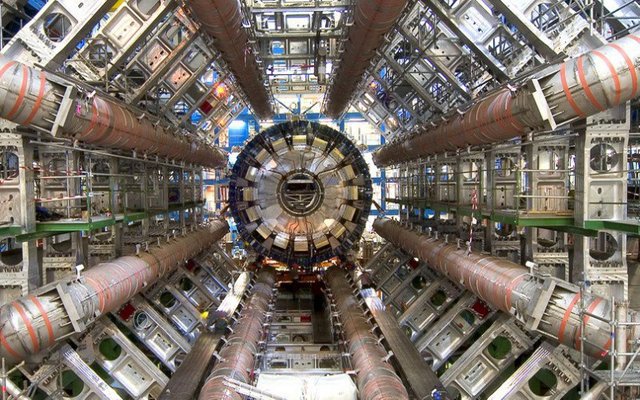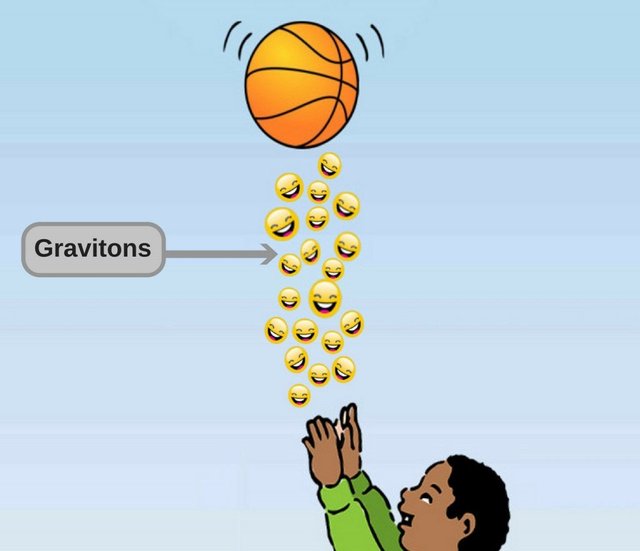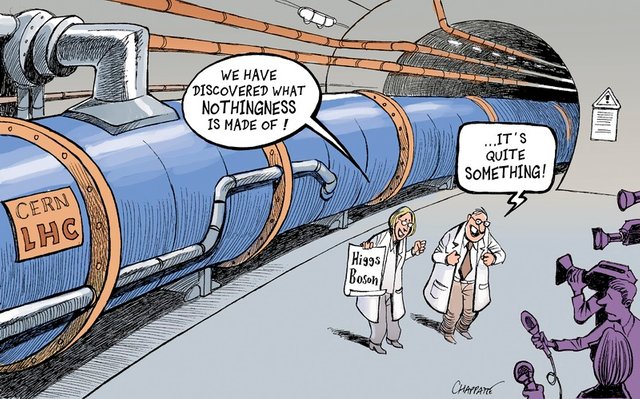Problems with the Standard Model of Modern Physics

I have yet to see any problem, however complicated, which when you looked at it the right way, did not become still more complicated.
—Poul Anderson
Standard Model physicists maintain that all of reality is a superposition of fields and what we call “particles” are really vibrations in these various fields. Despite this intriguing and ambitious stance, the “vibrations” are still treated as particles in almost every regard, and each class of vibration or particle is placed inside its own separate field. Placing each of these particles or vibrations in its own separate quantum field undermines the effort for a unified theory and suggests that each form of matter was created to serve an individual role, rather than arising naturally from the chaotic behavior of the field itself. That particles are considered fundamental, indivisible bits of matter reaffirms the suggestion that they did not arise from chaotic field behavior, while also assuring us that they are really considered particles, and not subtle vibrations in some ethereal medium.
For every force, observed or hypothetical, physicists that subscribe to the current paradigm try to explain the force through the action of hypothetical particles. For example, the force necessary to keep quarks together is called “the strong force,” and in order to explain the strong force, scientists invented massless “gluons,” particles which hypothetically shoot back and forth between the hypothetical quarks. The gluons are endowed with spins and symbolic colors to describe their varying interactions with the quarks, and all of these details are now taken for granted despite the fact that neither gluons nor quarks have ever been directly observed. Similarly, gauge bosons are considered the “force carriers,” responsible for transmitting forces between elementary particles. This of course begs the question of what transmits the forces between the bosons. We cannot simply invent a new particle to transmit force to every new particle we invent. We are also circumventing the obvious question: how can a particle exchange generate the strongest attractive force known to man, particularly when the particle being exchanged is massless? It’s as if I were to throw an imaginary, weightless ball at you, and this caused you to come flying toward me. The particle explanation makes no logical sense, but Standard Model physicists seem willing to disregard logical validity in order to preserve the lattice work of their paradigm. The same flimsy logic used in the gluon theory is repeated elsewhere. Gravity, for example, is explained in the same manner by the exchange of hypothetical “gravitons.” Somewhere, to avoid a reductio ad absurdum, force and mass must arise from the state of the universal field.

Author and physicist Sean Carroll wrote: “Does anyone really believe that God plays favorites with the particles?” He was referring to the ridiculous nickname for the Higgs Boson— “The God Particle.” Ironically, however, Carroll and others of his ilk seem to genuinely believe that God does “play favorites with the particles,” as they readily propose a variety of particles to carry out specific forces. Photons carry out the electromagnetic force. Gluons carry out the strong force binding quarks together. W and Z Bosons carry out the short-ranged “weak force.” Gravitons carry out the gravitational force. To Standard Model physicists, there really are distinct forces, operating according to completely different rules and employing completely different forms of matter. These forms of matter are not merely different in terms of mass or shape— they each possess forms of charge that cannot interact or be transformed into the charges of the other particles. The Standard Model is sometimes referred to as an “almost unified theory,” but it is in fact a collection of separate descriptions, some entirely hypothetical, that each fill a specific role. It is splintered and un-unifiable by its very design.
Attempts at unifying the Standard Model without altering its present structure are doomed to failure. The most significant examples of such attempts are the electroweak theory and the subsequent “Higgs Mechanism.” While neither attempts to unify the whole Model all at once, they are both indicative of the small stitches and Band-Aids being used to sew these disparate parts of the Standard Model into one Frankensteinian monster.
The electroweak theory posits that the electromagnetic and weak forces are different manifestations of a single force. While this statement is undoubtedly true, the structure of the Standard Model prevents this truth from being stated with any conviction. The theory ascribes electromagnetic interactions to photons and weak interactions to W and Z bosons, preserving a stark division between the two forces. The only unification to be found lies in the assertion that photons, W bosons, and Z bosons all become indistinguishable at ultra hot temperatures.
The Higgs Mechanism is an arbitrary construct used to resolve a paradox in the electroweak theory. The W and Z bosons proposed by the electroweak theory would have to be quite massive (around 80 GeV/c2) to account for the short range of the weak interaction, but if they have mass it would spoil the conservation of charge and energy, rendering the entire theory untenable. To resolve this contradiction, the Higgs Mechanism was invented, postulating a new quantum field permeating all of space, circumstantially providing mass to weak-interacting particles. Rather than mass being an inherent property of matter, the hypothetical charged field of the Higgs Mechanism allows massless particles to become massive in particular temperature ranges. In the words of writer and physicist Lisa Randall, “The magical property of the Higgs mechanism is that it lets you have your cake and eat it too: particles get mass, but they act as if they are massless when they have energies at which massive particles would otherwise cause problems… The weak charge that permeates space hinders the weak gauge bosons’ travel, making them behave exactly as they should in order to agree with experiments.” One should of course be skeptical of any “magical property” in physics, particularly when such a property is prescribed solely as a medicine for another theory.
Since the Standard Model insists on every quantum field having a hallmark force-carrying particle, the Higgs Boson was postulated as a consequence of the hypothetical Higgs field. Researchers believed that if they could find a Higgs Boson, they would prove the validity of the Higgs Mechanism. On July 4th, 2012, scientists at CERN’s Large Hadron Collider in Geneva announced that they had proved the existence of the Higgs Boson. Quickly hailed as “the most important discovery of the century,” the announcement justified the project’s multi-billion dollar budget and quickly led to much back-patting and self-congratulations. The facts of the announcement were extremely misleading, however, which is not surprising when one considers that the researchers had a vested interest in making that announcement. They had spent several years working on a multi-billion dollar project, all for the singular purpose of finding the Higgs boson. In the words of Lisa Randall, the researchers “deserved to find something. They had worked long and hard— and waited a great deal too.” An unfathomable amount money and reputation depended on finding the Higgs Boson, and so failing to find it would have been an unfathomable result.

The announcement of their success was misleading for two reasons. Number one: The reality of the Higgs field may imply the existence of a particle in a certain mass range, but finding a particle in that mass range does not imply the reality of the Higgs field. Imagine if I said, “All of Jackie’s kids have blonde hair.” Clearly, you wouldn’t conclude that every blonde-haired kid you see is the spawn of Jackie or a testament to Jackie’s existence, and yet the logic present in this ridiculous example is exactly analogous to the logic being used to justify the Higgs Mechanism. Number two: the Higgs Boson has never been observed. Its existence has only been implied by tangential observations, and the evidence is shaky at best.
The Higgs boson has never been directly observed, and it is produced only “rarely” out of billions of particle collisions. In order to prove the existence of the Higgs boson, experimenters wanted to find bottom quarks and bottom antiquarks, because these would be the most likely offspring of a Higgs decay. They couldn’t be identified, however, because there are already an enormous number of bottom quarks in the mix. There would be little reason to believe that any particularly quarks decayed from a Higgs boson unless we could watch the decay unfold, which we can’t. Because experimenters couldn’t point out the bottom quarks, they had to look elsewhere. The “discovery” was ultimately based off of observations of photons, which arguably decayed from top quarks and weak gauge bosons. Top quarks and weak gauge bosons are too massive to be produced by a Higgs boson, but quantum mechanics supposedly allows for the Higgs to decay into “particles that are too heavy to be made in nature.” The CERN researchers suggested that top quarks and weak gauge bosons could hypothetically be produced by roughly one fifth of a percent of all Higgs boson decays. If top quarks and weak gauge bosons were somehow produced by a Higgs boson, they would rapidly decay into photons. It is staggering to the imagination, then, that photon observations provided the sole article of evidence for the existence of the Higgs boson.

A Higgs boson is produced “rarely” out of billions of particle collisions and, assuming we accept the logic that a Higgs boson can produce particles “too heavy to be made in nature,” a Higgs Boson will decay into photons only .2% of the time. Thus, the photons the researchers searched for were created extremely rarely. Further, they had to be miraculously isolated from the chaotic din of surrounding photons and other particles. If the photons were identified with certainty, they might imply the existence of a weak gauge boson or a top quark, but they wouldn’t necessarily imply the presence of a Higgs boson. Even if they did imply the existence of a particle in the mass-range of the Higgs boson, it would hold no bearing on the validity of the Higgs Mechanism, because there would remain a litany of other plausible explanations for the source of the new-found particle.
If we suspend our disbelief (not to mention our common sense) and accept the evidence for the Higgs Boson and the Higgs Mechanism, neither does much to simplify or explain the Standard Model. While the electroweak theory aimed for a small degree of unification, it was only made tenable by the patchwork of the Higgs Mechanism, which introduced an entirely new weak-interacting field. In doing so, it completely reversed the electroweak theory’s small progress toward unification. In order to make two fields become one, a third had to be introduced. This is hardly the sort of progress one would hope for an “almost unified theory.” The Higgs Mechanism is also reputed as the source of mass in a wide variety of matter, but it does not provide any explanation for the observed values of those masses, nor does it provide mass to all of matter— just electrons, quarks, and weak gauge bosons. Most of the mass in the universe is attributed to the effect of the strong force binding quarks together inside of protons and neutrons. Mass in this paradigm can be bestowed by forces that shun specific particles while targeting others, creating a hydra out of what was initially a single, well-defined concept.
The mass-energy equivalence that physicists supposedly revere is readily discarded when it becomes inconvenient to the Standard Model. The Higgs Field itself is said to have energy and charge at all locations in space, but no mass. It can even produce the massive Higgs Boson, despite having no mass with which to produce it. Photons, which have energy and charge, are considered entirely massless, because Relativity tells us that nothing with mass can achieve the speed of light. The same scientists who say that energetic particles and fields can be massless are also prone to make statements like this: “…whenever we’re faced with an amount of mass, we simply multiply it by the speed of light squared to instantly convert it into an energy. That way we can measure everything in terms of energy, which is much more convenient.” Why, then, can we not divide energy by the speed of light squared and then find a mass? These theorists have become so accustomed to “having their cake and eating it too” that they are willing to use mass-energy equivalence for their convenience, then completely ignore it when it contradicts their paradigm.
The Standard Model is, essentially, humanity's collective best effort at explaining the physical nature of our reality, yet, as we have seen, it is a haphazard amalgamation of ad hoc theories which frequently overlap and contradict each other. In order to achieve the "Grand Unified Theory" that we are striving for, The Standard Model will have to be left behind or radically overhauled. We cannot persist in a paradigm which has demonstrated such a blatant disregard for logic, reason, simplicity, or efficiency.
Cover Image: Image Source
I find this all fascinating. I did not know about all the holes in their conclusions. I knew some of them.
I first read about quarks in 2005 when they were talking about a processor that used suspended quarks to do the processing equivalent to that of 12,228 CPU's. While I was looking for that article, I saw this one from three days ago on top quarks interaction with the Hb. After reading your thoughts above, I have trouble believing much of what they print.
I think they love the grant money.
Simplified Explanation
Hahaha I definitely agree they love that grant money. But that's crazy though about the quark computing... Had no idea they had come that far, and as early as 2005! Sheesh.
interesting post friend do you like modern physics?
Yes, the theories we have are placeholders until better models can be created.
Celebrate your return on particle physics. The fact that electrical theory has so many loopholes that science can not yet solve
Es algo dificil de entender pero hemos cambiado mucho nuestro modelos psiquicos en los ultimos años @youdontsay